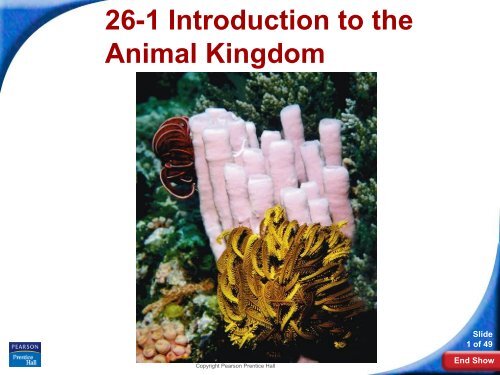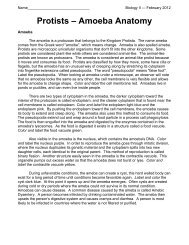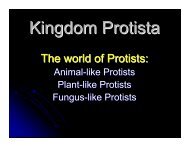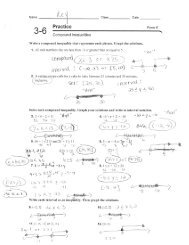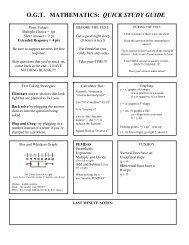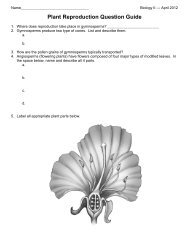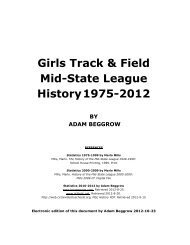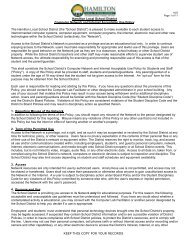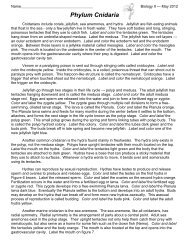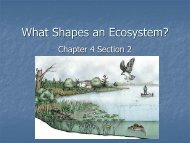26-1 Introduction to the Animal Kingdom - Hamilton Local Schools
26-1 Introduction to the Animal Kingdom - Hamilton Local Schools
26-1 Introduction to the Animal Kingdom - Hamilton Local Schools
You also want an ePaper? Increase the reach of your titles
YUMPU automatically turns print PDFs into web optimized ePapers that Google loves.
<strong>26</strong>-1 <strong>Introduction</strong> <strong>to</strong> <strong>the</strong><strong>Animal</strong> <strong>Kingdom</strong>Slide1 of 49Copyright Pearson Prentice HallEnd Show
Which of <strong>the</strong>se is an “animal?”Slide2 of 49End Show
Answer: They are all animals!Characteristics of <strong>Animal</strong>s:heterotrophicEukaryoticmulticellularlack cell walls.Slide3 of 49End Show
<strong>26</strong>-1 <strong>Introduction</strong> <strong>to</strong> <strong>the</strong> <strong>Animal</strong><strong>Kingdom</strong>What Is an <strong>Animal</strong>?<strong>Animal</strong>s have <strong>the</strong> following types of tissues:•epi<strong>the</strong>lial•muscular•connective•nervousSlide4 of 49Copyright Pearson Prentice HallEnd Show
<strong>26</strong>-1 <strong>Introduction</strong> <strong>to</strong> <strong>the</strong> <strong>Animal</strong><strong>Kingdom</strong>What Is an <strong>Animal</strong>?Invertebrates make up 95% of all animal species.Invertebrates do not have a backbone, or vertebralcolumn.They include sea stars, worms, jellyfishes, andinsects.Copyright Pearson Prentice HallSlide5 of 49End Show
<strong>26</strong>-1 <strong>Introduction</strong> <strong>to</strong> <strong>the</strong> <strong>Animal</strong><strong>Kingdom</strong>What Is an <strong>Animal</strong>?The o<strong>the</strong>r 5% of animals are vertebrates.Vertebrates have a backbone.Vertebrates include fishes, amphibians, reptiles,birds, and mammals.Copyright Pearson Prentice HallSlide6 of 49End Show
<strong>26</strong>-1 <strong>Introduction</strong> <strong>to</strong> <strong>the</strong> <strong>Animal</strong><strong>Kingdom</strong>What <strong>Animal</strong>s Do <strong>to</strong> Survive<strong>Animal</strong>s carry out <strong>the</strong> following essentialfunctions:• feeding• respiration• circulation• excretion• response• movement• reproductionCopyright Pearson Prentice HallSlide7 of 49End Show
<strong>26</strong>-1 <strong>Introduction</strong> <strong>to</strong> <strong>the</strong> <strong>Animal</strong><strong>Kingdom</strong>What <strong>Animal</strong>s Do <strong>to</strong> SurviveFeedingHerbivores eat plants.Carnivores eat o<strong>the</strong>r animals.Omnivores feed on both plants and animals.Detritivores feed on decaying plant and animalmaterial.Filter feeders are aquatic animals that strain tinyfloating organisms from water.Slide8 of 49Copyright Pearson Prentice HallEnd Show
<strong>26</strong>-1 <strong>Introduction</strong> <strong>to</strong> <strong>the</strong> <strong>Animal</strong><strong>Kingdom</strong>What <strong>Animal</strong>s Do <strong>to</strong> SurviveRespirationWhe<strong>the</strong>r <strong>the</strong>y live in water or on land, all animalsrespire—<strong>the</strong>y take in oxygen and give off carbondioxide.Slide9 of 49Copyright Pearson Prentice HallEnd Show
<strong>26</strong>-1 <strong>Introduction</strong> <strong>to</strong> <strong>the</strong> <strong>Animal</strong><strong>Kingdom</strong>What <strong>Animal</strong>s Do <strong>to</strong> SurviveCirculation<strong>Animal</strong>s transport oxygen, nutrient molecules, andwaste products among all <strong>the</strong>ir cells through ei<strong>the</strong>rsimple diffusion or some kind of circula<strong>to</strong>ry systemSlide10 of 49Copyright Pearson Prentice HallEnd Show
<strong>26</strong>-1 <strong>Introduction</strong> <strong>to</strong> <strong>the</strong> <strong>Animal</strong><strong>Kingdom</strong>What <strong>Animal</strong>s Do <strong>to</strong> SurviveExcretionAmmonia is a waste product of cells and apoisonous substance.Most animals have an excre<strong>to</strong>ry system thateliminates ammonia quickly or converts it in<strong>to</strong> aless <strong>to</strong>xic substance that is removed from <strong>the</strong>body.Slide11 of 49Copyright Pearson Prentice HallEnd Show
<strong>26</strong>-1 <strong>Introduction</strong> <strong>to</strong> <strong>the</strong> <strong>Animal</strong><strong>Kingdom</strong>What <strong>Animal</strong>s Do <strong>to</strong> SurviveResponse<strong>Animal</strong>s respond <strong>to</strong> events in <strong>the</strong>ir environmentusing specialized cells, called nerve cells. In mostanimals, nerve cells form a nervous system.Slide12 of 49Copyright Pearson Prentice HallEnd Show
<strong>26</strong>-1 <strong>Introduction</strong> <strong>to</strong> <strong>the</strong> <strong>Animal</strong><strong>Kingdom</strong>What <strong>Animal</strong>s Do <strong>to</strong> SurviveMovementSome animals stay at a single spot, but most canmove. Most animals have muscles or muscleliketissues.Muscle contraction enables motile animals <strong>to</strong> movearound by working in combination with a supportstructure called a skele<strong>to</strong>n.Muscles also help even sedentary animals feedand pump water and fluids through <strong>the</strong>ir bodies.Slide13 of 49Copyright Pearson Prentice HallEnd Show
<strong>26</strong>-1 <strong>Introduction</strong> <strong>to</strong> <strong>the</strong> <strong>Animal</strong><strong>Kingdom</strong>What <strong>Animal</strong>s Do <strong>to</strong> SurviveReproductionMost animals reproduce sexually. This helps <strong>to</strong>create and maintain genetic diversity inpopulations and improve species’ abilities <strong>to</strong>evolve when <strong>the</strong> environment changes.Many invertebrates can also reproduce asexually.This produces offspring that are geneticallyidentical <strong>to</strong> <strong>the</strong> parent. It allows animals <strong>to</strong> increase<strong>the</strong>ir numbers rapidly.Slide14 of 49Copyright Pearson Prentice HallEnd Show
<strong>26</strong>-1 <strong>Introduction</strong> <strong>to</strong> <strong>the</strong> <strong>Animal</strong><strong>Kingdom</strong>Trends in <strong>Animal</strong> EvolutionComplex animals tend <strong>to</strong> have:• high levels of cell specialization andinternal body organization• bilateral body symmetry• a front end or head with sense organs• a body cavitySlide15 of 49Copyright Pearson Prentice HallEnd Show
<strong>26</strong>-1 <strong>Introduction</strong> <strong>to</strong> <strong>the</strong> <strong>Animal</strong><strong>Kingdom</strong>Trends in <strong>Animal</strong> EvolutionEarly Development<strong>Animal</strong>s that reproduce sexually begin life as azygote, or fertilized egg.Slide16 of 49Copyright Pearson Prentice HallEnd Show
<strong>26</strong>-1 <strong>Introduction</strong> <strong>to</strong> <strong>the</strong> <strong>Animal</strong><strong>Kingdom</strong>Trends in <strong>Animal</strong> EvolutionThe zygote undergoes a series of divisions <strong>to</strong> forma blastula, a hollow ball of cells.Copyright Pearson Prentice HallSlide17 of 49End Show
<strong>26</strong>-1 <strong>Introduction</strong> <strong>to</strong> <strong>the</strong> <strong>Animal</strong><strong>Kingdom</strong>Trends in <strong>Animal</strong> EvolutionA pro<strong>to</strong>s<strong>to</strong>me is ananimal whose mouth isformed from <strong>the</strong>blas<strong>to</strong>pore.Ec<strong>to</strong>dermMesodermEndodermBlas<strong>to</strong>poreMost invertebrate animalsare pro<strong>to</strong>s<strong>to</strong>mes.AnusBlas<strong>to</strong>pore becomes mouthCopyright Pearson Prentice HallSlide18 of 49End Show
<strong>26</strong>-1 <strong>Introduction</strong> <strong>to</strong> <strong>the</strong> <strong>Animal</strong><strong>Kingdom</strong>Trends in <strong>Animal</strong> EvolutionA deuteros<strong>to</strong>me is ananimal whose anus isformed from <strong>the</strong>blas<strong>to</strong>pore.The anus is <strong>the</strong> openingthrough which wastesleave <strong>the</strong> digestive tract.Ec<strong>to</strong>dermMesodermEndodermBlas<strong>to</strong>poreMouthCopyright Pearson Prentice HallBlas<strong>to</strong>pore becomes anusSlide19 of 49End Show
<strong>26</strong>-1 <strong>Introduction</strong> <strong>to</strong> <strong>the</strong> <strong>Animal</strong><strong>Kingdom</strong>Trends in <strong>Animal</strong> EvolutionEchinoderms andvertebrates are bothdeuteros<strong>to</strong>mes.Copyright Pearson Prentice HallSlide20 of 49End Show
<strong>26</strong>-1 <strong>Introduction</strong> <strong>to</strong> <strong>the</strong> <strong>Animal</strong><strong>Kingdom</strong>Trends in <strong>Animal</strong> EvolutionThis similarity inembryology mayindicate that vertebrateshave a closerevolutionary relationship<strong>to</strong> echinoderms than <strong>to</strong>o<strong>the</strong>r invertebrates.Copyright Pearson Prentice HallSlide21 of 49End Show
<strong>26</strong>-1 <strong>Introduction</strong> <strong>to</strong> <strong>the</strong> <strong>Animal</strong><strong>Kingdom</strong>Trends in <strong>Animal</strong> EvolutionThe cells of <strong>the</strong> endoderm, or innermost germ layer,develop in<strong>to</strong> <strong>the</strong> linings of <strong>the</strong> digestive tract andmuch of <strong>the</strong> respira<strong>to</strong>ry system.EndodermOnly <strong>the</strong> label “endoderm”should appear on this slide.Slide22 of 49Copyright Pearson Prentice HallEnd Show
<strong>26</strong>-1 <strong>Introduction</strong> <strong>to</strong> <strong>the</strong> <strong>Animal</strong><strong>Kingdom</strong>Trends in <strong>Animal</strong> EvolutionThe cells of <strong>the</strong> mesoderm, or middle layer, developin<strong>to</strong> muscles and much of <strong>the</strong> circula<strong>to</strong>ry,reproductive, and excre<strong>to</strong>ry organ systems.MesodermSlide23 of 49Copyright Pearson Prentice HallEnd Show
<strong>26</strong>-1 <strong>Introduction</strong> <strong>to</strong> <strong>the</strong> <strong>Animal</strong><strong>Kingdom</strong>Trends in <strong>Animal</strong> EvolutionThe ec<strong>to</strong>derm, or outermost layer, develops in<strong>to</strong> <strong>the</strong>sense organs, nerves, and <strong>the</strong> outer layer of <strong>the</strong> skin.Ec<strong>to</strong>dermSlide24 of 49Copyright Pearson Prentice HallEnd Show
<strong>26</strong>-1 <strong>Introduction</strong> <strong>to</strong> <strong>the</strong> <strong>Animal</strong><strong>Kingdom</strong>Body SymmetryExcept for sponges, every animal exhibits some bodysymmetry in its structure.Slide25 of 49Copyright Pearson Prentice HallEnd Show
<strong>26</strong>-1 <strong>Introduction</strong> <strong>to</strong> <strong>the</strong> <strong>Animal</strong><strong>Kingdom</strong>Body SymmetryTrends in <strong>Animal</strong> EvolutionMany simple animals, like <strong>the</strong> sea anemone, havebody parts that repeat around <strong>the</strong> center of <strong>the</strong>body.Slide<strong>26</strong> of 49Copyright Pearson Prentice HallEnd Show
<strong>26</strong>-1 <strong>Introduction</strong> <strong>to</strong> <strong>the</strong> <strong>Animal</strong><strong>Kingdom</strong>These animals exhibitradial symmetry, inwhich any number ofimaginary planes can bedrawn through <strong>the</strong>center, each dividing <strong>the</strong>body in<strong>to</strong> equal halves.Trends in <strong>Animal</strong> EvolutionRadial symmetryPlanes ofsymmetrySlide27 of 49Copyright Pearson Prentice HallEnd Show
<strong>26</strong>-1 <strong>Introduction</strong> <strong>to</strong> <strong>the</strong> <strong>Animal</strong><strong>Kingdom</strong>Trends in <strong>Animal</strong> EvolutionIn animals withbilateral symmetry,only one imaginaryplane can divide <strong>the</strong>body in<strong>to</strong> two equalhalves—left andright.Plane ofsymmetryBilateral symmetryCopyright Pearson Prentice HallSlide28 of 49End Show
Identify <strong>the</strong> SymmetrySlide29 of 49Copyright Pearson Prentice HallEnd Show
<strong>26</strong>-1 <strong>Introduction</strong> <strong>to</strong> <strong>the</strong> <strong>Animal</strong><strong>Kingdom</strong>Trends in <strong>Animal</strong> EvolutionThe anterior is <strong>the</strong>front end.The posterior is <strong>the</strong>back end.Anterior endPosterior endBilateral symmetryCopyright Pearson Prentice HallSlide30 of 49End Show
<strong>26</strong>-1 <strong>Introduction</strong> <strong>to</strong> <strong>the</strong> <strong>Animal</strong><strong>Kingdom</strong>Trends in <strong>Animal</strong> EvolutionThe dorsal is <strong>the</strong> upperside.Dorsal sideThe ventral is <strong>the</strong> lowerside.VentralsideBilateral symmetryCopyright Pearson Prentice HallSlide31 of 49End Show
<strong>26</strong>-1 <strong>Introduction</strong> <strong>to</strong> <strong>the</strong> <strong>Animal</strong><strong>Kingdom</strong>Trends in <strong>Animal</strong> EvolutionCephalization<strong>Animal</strong>s with bilateral symmetry exhibitcephalization, which is <strong>the</strong> concentration of senseorgans and nerve cells at <strong>the</strong> front end of <strong>the</strong> body.Slide32 of 49Copyright Pearson Prentice HallEnd Show
<strong>26</strong>-1 <strong>Introduction</strong> <strong>to</strong> <strong>the</strong> <strong>Animal</strong><strong>Kingdom</strong>Trends in <strong>Animal</strong> EvolutionBody Cavity FormationMost animals have a body cavity, a fluid-filledspace between <strong>the</strong> digestive tract and body wall.A body cavity provides a space in which internalorgans can be suspended so that <strong>the</strong>y are notpressed on by muscles or twisted out of shape bybody movements.Slide33 of 49Copyright Pearson Prentice HallEnd Show
<strong>Animal</strong> <strong>Kingdom</strong> PhylaPhylum Porifera– spongesPhylum Cnidaria– sea anemones,jellyfish, hydraSlide34 of 49End Show
Phylum Platyhelmin<strong>the</strong>s - flatwormsFree-living PlanarianParasitic TapewormSlide35 of 49End Show
Phylum Nema<strong>to</strong>da –roundwormsPhylum Annelida –segmented wormsSlide36 of 49End Show
Phylum Mollusca – clams, squid, snailsSlide37 of 49End Show
Phylum Arthropoda – crustaceans,insects, spidersThis is <strong>the</strong> largest phylum in<strong>the</strong> animal kingdom andcontains <strong>the</strong> most number ofspeciesSlide38 of 49End Show
Phylum Echinodermata - starfishSlide39 of 49End Show
Phylum Chordata – includesall vertebratesSlide40 of 49End Show
<strong>26</strong>-1Continue <strong>to</strong>:- or -Click <strong>to</strong> Launch:Slide41 of 49Copyright Pearson Prentice HallEnd Show
<strong>26</strong>-1<strong>Animal</strong>s respond <strong>to</strong> events in <strong>the</strong>ir environmentsusing specialized cells calleda. muscle cells.b. nerve cells.c. gametes.d. blood cells.Slide42 of 49Copyright Pearson Prentice HallEnd Show
<strong>26</strong>-1A characteristic that all animals share is beinga. heterotrophic.b. au<strong>to</strong>trophic.c. prokaryotic.d. anaerobic.Slide43 of 49Copyright Pearson Prentice HallEnd Show
<strong>26</strong>-1Excretion is a function of all animals thatinvolvesa. exchange of oxygen and carbon dioxide.b. transport of material from one part of <strong>the</strong>body <strong>to</strong> ano<strong>the</strong>r.c. digestion and absorption of food molecules.d. removal of metabolic wastes.Slide44 of 49Copyright Pearson Prentice HallEnd Show
<strong>26</strong>-1One major trend in animal evolution has beena. <strong>the</strong> simplification of body organ systems.b. an increase in <strong>the</strong> degree of cephalization.c. a shift from bilateral symmetry <strong>to</strong> radialsymmetry.d. disappearance of <strong>the</strong> blastula stage in earlydevelopment.Slide45 of 49Copyright Pearson Prentice HallEnd Show


